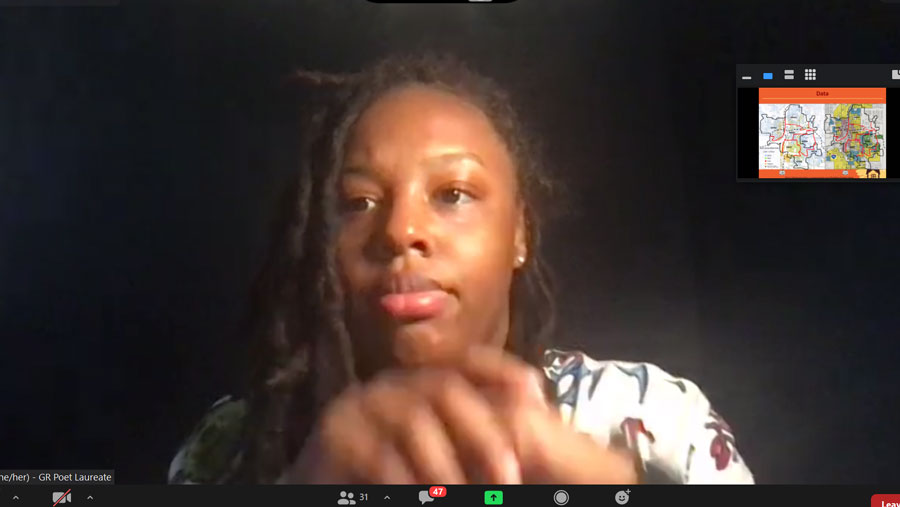Grand Rapids — About half an hour into a class discussion about the history of housing discrimination in Grand Rapids, poet Marcel “Fable” Price asks students, “What would make your neighborhood feel more like home to you?”
The Ottawa Hills High School classmates quickly text him their thoughts over Zoom.
Janya: “Going back to elementary days the way I felt idk” and “the playing outside”
Quimora: “if grown ups would stop arguing all the time”
Janya again: “Everyone being together”
Dayven: “Jst (sic) to keep up with the homes, make me feel as if the world isn’t attacking us”
It’s a revealing moment in an hour’s worth of dialogue in Peter Walblay’s English class, led by Price and other leaders of The Diatribe, a community-based nonprofit that offers workshops, assemblies and other programming to area schools. Through poetry and spoken word, students are encouraged to explore social issues like racism as well as personal challenges such as mental health.
Partnering with the Fair Housing Center of West Michigan, The Diatribe conducted a nine-week unit in Walblay’s class focusing on how racist policies contributed to segregated housing patterns in Grand Rapids. Students responded with written reflections in a Diatribe class called “Writing to Right Wrongs,” exploring not only historical trends but their own neighborhood experiences.
Though the class was hosted by Walblay previously, as chronicled in a 2019 School News Network video story, this time students’ voices reached beyond the classroom. They shared their ideas with seven artists of color to help shape The 49507 Project, a series of educational, anti-racist murals to be painted this summer on businesses in that Southeast Side zip code. The Zoom session included artists such as Erick Picardo and Grand Rapids poet laureate Kyd Kane.

Elevating Student Voices
The combination of creative expression and community involvement is a big plus for his students, said Walblay, a seventh-year teacher.
“It’s important for young people to be listened to, and I feel The Diatribe does a good job of providing that platform,” Walblay said. “Young people have a lot to say, and very unfairly they’re often overlooked. Any opportunity to uplift students’ voices in the community is an opportunity well-taken.”
Some of his students will help develop The 49507 Project, which will include community listening sessions and a late-summer mural unveiling, and along other students will have the opportunity of summer programming in poetry and self-expression. Their comments and writings will help inform the muralists’ artworks.
“They’re writing about their lived experiences,” said Price, executive director of The Diatribe and former Grand Rapids poet laureate. “Their lived experiences when it comes to their experiences in their neighborhoods, the experiences that their families have had, or their experience in the world.”
Through “Writing to Right Wrongs,” students learn about racist realities that affected where their parents and grandparents were able to live, such as redlining, a government practice begun in the 1930s of drawing red lines around Black and poor neighborhoods where mortgage lenders and insurers would not invest.
‘Anti-racist art looks like two divided communities in unison, showing them as equals instead of one over the other.’
– Marshaun, Ottawa Hills High School freshman
Students saw a loan corporation’s 1937 “residential security map” of Grand Rapids that color-coded areas from most to least desirable. Price also called their attention to a map document designating one neighborhood as having an “infiltration of Italians & Negroes.”
The boundaries drawn then are still evident in concentrations of people of color and under-invested neighborhoods, Price said.
“These are like maybe your great-grandparents,” he said. “The reason some of them were refused loans was because of who they were.”

What Neighborhoods Should Look Like
Ninth-grader Dayven said he was familiar with redlining and other injustices, but that the class motivated him to help spread awareness about racial discrimination.
“I think The Diatribe kind of pushed me to talk about it more, pushed the idea out there,” said Dayven, adding he wants to stay active in The 49507 Project. “I feel The Diatribe has given me that voice to spread the word.”
He shared his voice through a poem, “In My Eyes,” in which he decries racism and police killings of Black people: “The one problem in this world is ignorance/ This life of/ ‘it just is’/ needs to change to ‘justice.’
But classmate Marshaun said while he learned from the class, he hasn’t felt touched personally by housing discrimination or racism. Rather than get politically involved, he said he’d prefer to teach kids how to play guitar and help with their homework at City View Church.
‘Young people have a lot to say, and very unfairly they’re often overlooked.’
– Peter Walblay, Ottawa Hills English teacher
“You’ve got the power to speak; it just depends on what you’re speaking on,” Marshaun said. “I want to teach people to be their own selves and not follow everybody else.”
He contributed his thoughts in class on what anti-racist murals should look like: “Anti-racist art looks like two divided communities in unison, showing them as equals instead of one over the other.”
Asked what their neighborhoods would look like if they had more control over them, students texted some big-dream thoughts: “Colorful.” “Better everything, like schools, stores etc.” “Way more flavor.” “More nature.”
And if they had art that reclaimed their neighborhoods, what might it say or look like? Price asked, mindful of the artists on the Zoom.
“I’m thinking it would look divine and unique,” Marshaun said. “Something different, something new … an abstract portrait of something.”
“Oh, the words y’all are choosing!” Price exclaimed. “Yes, yes! These artists are sponges right now. They’re soaking in what you all have to say. This art that’s going to live is from this, right now, right here.”









